African Manatee Training Workshop in Djenne, Mali
 We had 1-2 lectures each day on topics including manatee biology and evolution, research techniques, sample collection, and field equipment.
We had 1-2 lectures each day on topics including manatee biology and evolution, research techniques, sample collection, and field equipment. The first day we went over environmental sampling equipment such as GPS units, depth sounders, salinity meters, and other basic tools the participants will need to record the manatee’s habitat in their home countries.
The first day we went over environmental sampling equipment such as GPS units, depth sounders, salinity meters, and other basic tools the participants will need to record the manatee’s habitat in their home countries.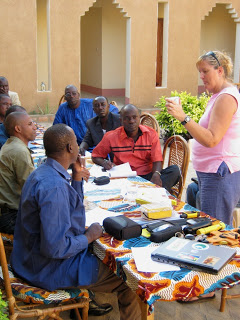 This was our boat (or “pinasse” in the local French) for field outings. It was nice to have a cover from the hot sun.
This was our boat (or “pinasse” in the local French) for field outings. It was nice to have a cover from the hot sun. On our first field trip participants learned how to use field sampling equipment. In this photo Berthe from San, Mali uses the GPS.
On our first field trip participants learned how to use field sampling equipment. In this photo Berthe from San, Mali uses the GPS.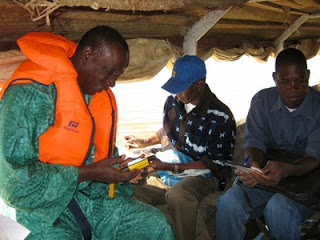 We had two different types of depth sounders, this one (being tested by Boureima from Niger) also records water and air temperature as well as detecting animals moving below the water’s surface.
We had two different types of depth sounders, this one (being tested by Boureima from Niger) also records water and air temperature as well as detecting animals moving below the water’s surface.
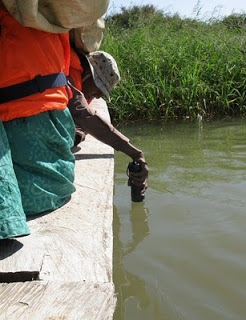 Timbo from the Dept. of Water and Forestry in Mali checks the reading on the other type of depth sounder.
Timbo from the Dept. of Water and Forestry in Mali checks the reading on the other type of depth sounder. I sponsored three participants from outside Mali, including Wachoum from Chad (looking through binocs), Kouame from Ivory Coast (middle) and Boureima from Niger.
I sponsored three participants from outside Mali, including Wachoum from Chad (looking through binocs), Kouame from Ivory Coast (middle) and Boureima from Niger.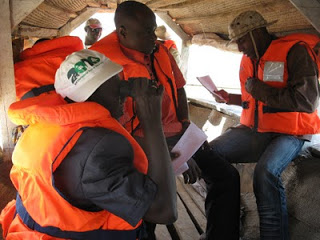 On our first and second outings we also went to local villages so participants could practice manatee interview techniques. The Bozo people are the fishermen in this area and they have alot of local knowledge about manatees.
On our first and second outings we also went to local villages so participants could practice manatee interview techniques. The Bozo people are the fishermen in this area and they have alot of local knowledge about manatees.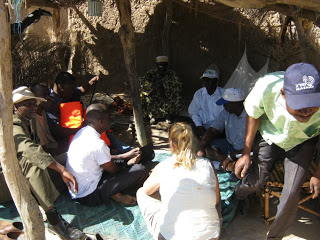 In the interview at the village of Syndaga, Diakite of the Water and Forestry Ministry from Djenne (on left) led the questions with village elders. They see manatees in this area year round and explained mating herds by a story calling it a “manatee wedding” where the manatees gather to celebrate a bride and groom.
In the interview at the village of Syndaga, Diakite of the Water and Forestry Ministry from Djenne (on left) led the questions with village elders. They see manatees in this area year round and explained mating herds by a story calling it a “manatee wedding” where the manatees gather to celebrate a bride and groom.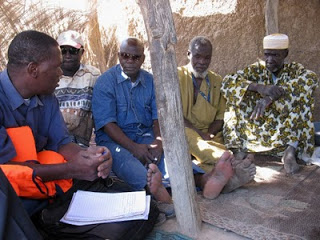 At the end of the interview some of the villagers wanted to have a photo with our group. People here recognized the local workshop participants that were from Djenne, which greatly helped us gain their trust for the interview.
At the end of the interview some of the villagers wanted to have a photo with our group. People here recognized the local workshop participants that were from Djenne, which greatly helped us gain their trust for the interview. Participants also gave lectures about manatee research in their country. Here Boureima discusses his research in W National Park in Niger (so named because the Niger River forms a “W” in this area).
Participants also gave lectures about manatee research in their country. Here Boureima discusses his research in W National Park in Niger (so named because the Niger River forms a “W” in this area).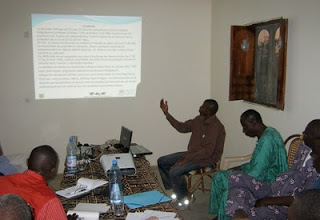 I also led the group in a discussion of manatee necropsy techniques. We didn’t have an actual manatee carcass for demonstration, so for measurements we used an inflatable orca (I was unable to locate an inflatable manatee so this was as close as I could get. If anyone knows where I can get a manatee for future training use, please let me know!)
I also led the group in a discussion of manatee necropsy techniques. We didn’t have an actual manatee carcass for demonstration, so for measurements we used an inflatable orca (I was unable to locate an inflatable manatee so this was as close as I could get. If anyone knows where I can get a manatee for future training use, please let me know!)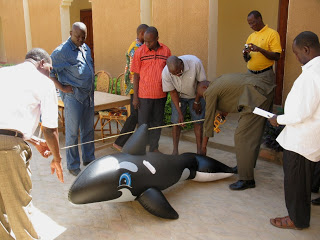 Practicing girth measurements…
Practicing girth measurements…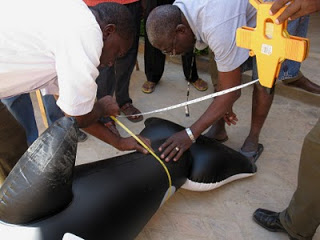 During breaks and free time participants had lots of opportunities to talk about their work and what they hope to achieve in their countries.
During breaks and free time participants had lots of opportunities to talk about their work and what they hope to achieve in their countries.
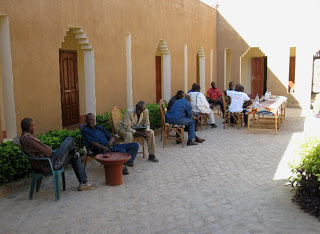 Kouame from Ivory Coast had an example of a t-shirt his program has distributed there, urging people not to kill manatees.
Kouame from Ivory Coast had an example of a t-shirt his program has distributed there, urging people not to kill manatees. I’d like to thank my colleagues in Mali who assisted in setting up the workshop: Semega and Guindo from Niger River Basin Authority, and Timbo from the Ministry of Water and Forestry.
I’d like to thank my colleagues in Mali who assisted in setting up the workshop: Semega and Guindo from Niger River Basin Authority, and Timbo from the Ministry of Water and Forestry. This is most of the group on the last day, after I handed out donations of field equipment (one set for each country, hopefully I can fund more in the future) to help their manatee data collection. The money for this equipment was made possible by generous grants from several funders.
This is most of the group on the last day, after I handed out donations of field equipment (one set for each country, hopefully I can fund more in the future) to help their manatee data collection. The money for this equipment was made possible by generous grants from several funders.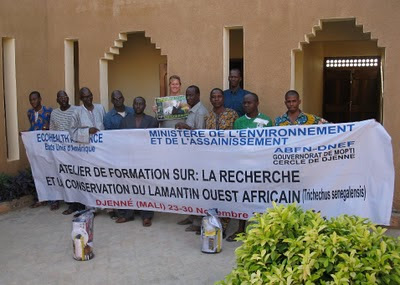
Thanks to all the participants for all your interest in manatee conservation! I look forward to hearing how your work progresses!
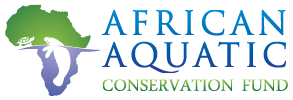
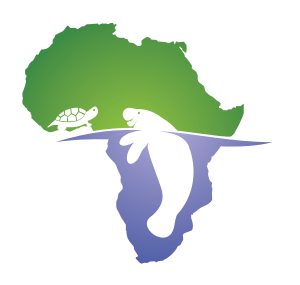
Hi Lucy,
It was an exciting moment during this session!
I gained a lot and hope that this will just be the begining!
keep it up!
Boureima from Niger
Thanks Boureima, I look forward to hearing about your fieldwork! Best of luck to you.